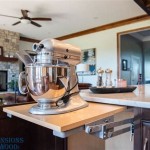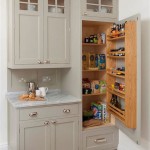Best Way to Clean Kitchen Cabinets Wood
Maintaining the cleanliness of kitchen cabinets, particularly those constructed of wood, is crucial for preserving both their aesthetic appeal and structural integrity. Wood cabinets are susceptible to accumulating grease, grime, food splatters, and dust, which can degrade the finish over time and create an unsanitary environment. Implementing a regular cleaning routine, coupled with appropriate cleaning methods, is essential to ensure the longevity and beauty of these vital kitchen components.
The selection of cleaning products and techniques is paramount when dealing with wood cabinets. Harsh chemicals and abrasive materials can damage the wood's surface, stripping the finish and leading to discoloration or scratches. Conversely, gentle cleaning solutions and soft cloths are effective in removing common kitchen grime without causing harm. The optimal approach involves understanding the type of wood and finish applied to the cabinets, followed by the application of appropriate cleaning methods tailored to those specific characteristics.
Frequency of cleaning also plays a significant role in maintaining cabinet condition. While deep cleaning may be required less frequently, regular wiping down of surfaces can prevent the buildup of stubborn stains and residue. Establishing a consistent cleaning schedule allows for proactive maintenance, minimizing the need for more intensive cleaning processes in the long run. This systematic approach extends the lifespan of the cabinets and contributes to a cleaner, more hygienic kitchen environment.
Preparation is Key: Assembling Your Cleaning Arsenal
Before commencing the cleaning process, it is essential to gather the necessary cleaning supplies and tools. This proactive step ensures efficiency and minimizes potential disruptions during the cleaning process. The essential components of a wood cabinet cleaning arsenal include:
Soft cloths or microfiber cloths: These cloths are gentle on wood surfaces and effectively trap dust and grime without scratching the finish. Multiple cloths are recommended to ensure a clean surface is always in contact with the cabinets.
Warm water: Warm water acts as a solvent, loosening dirt and grease for easier removal. It is a fundamental component of most cleaning solutions and should be readily available.
Mild dish soap: A small amount of mild dish soap, when diluted in warm water, provides a gentle yet effective cleaning solution for removing grease and food particles. The soap should be free of harsh chemicals and abrasives.
White vinegar (optional): White vinegar is a natural cleaning agent that can help to cut through grease and remove stubborn stains. It should be diluted with water to avoid damaging the wood finish. A solution of equal parts white vinegar and water is generally recommended.
Baking soda (optional): Baking soda is a mild abrasive that can be used to tackle particularly stubborn stains or baked-on grease. It should be used sparingly and with caution to avoid scratching the wood.
Spray bottle: A spray bottle allows for even distribution of the cleaning solution onto the cabinet surfaces. This ensures consistent cleaning and minimizes the risk of over-saturation.
Soft-bristled brush (optional): A soft-bristled brush can be used to clean intricate details and crevices on the cabinets. It is particularly useful for removing dirt from raised panel doors or decorative trim.
Clean bucket or bowl: A clean bucket or bowl is needed to mix the cleaning solution. It is important to use a clean container to avoid introducing contaminants to the cleaning process.
Protective gloves: Wearing protective gloves protects the hands from prolonged exposure to cleaning solutions and potential irritants.
Old toothbrush (optional): An old toothbrush can be used to reach tight corners and crevices that are difficult to clean with a cloth or brush.
Dry towel: A dry towel is essential for drying the cabinets after cleaning to prevent water spots and moisture damage.
Once the necessary supplies are gathered, the cleaning process can be initiated with greater efficiency and effectiveness.
The Cleaning Process: Step-by-Step Guide
The cleaning process for wood kitchen cabinets should be approached systematically to ensure thoroughness and minimize the risk of damage. The following steps provide a comprehensive guide for cleaning wood cabinets:
Dusting: Begin by dusting the cabinets with a soft cloth or microfiber cloth. This removes loose dirt and debris, preventing it from being spread around during the cleaning process. Be sure to dust all surfaces, including the tops, sides, and bottoms of the cabinets.
Prepare the cleaning solution: Mix a small amount of mild dish soap in a bucket of warm water. Alternatively, prepare a solution of equal parts white vinegar and water. If using baking soda, create a paste by mixing it with a small amount of water.
Test the cleaning solution: Before applying the cleaning solution to the entire cabinet surface, test it on an inconspicuous area, such as the inside of a cabinet door, to ensure it does not damage the finish. Allow the solution to sit for a few minutes, then wipe it off and observe the area for any discoloration or damage.
Apply the cleaning solution: Dip a soft cloth into the cleaning solution, wring out the excess moisture, and gently wipe down the cabinet surfaces. Avoid oversaturating the wood, as excess moisture can damage the finish. If using a spray bottle, lightly spray the cleaning solution onto the cabinets and wipe with a clean cloth.
Clean stubborn stains: For stubborn stains or baked-on grease, apply a small amount of baking soda paste to the affected area. Gently scrub with a soft cloth or toothbrush, then wipe clean with a damp cloth. Avoid using excessive pressure, as this can scratch the wood.
Rinse with clean water: After cleaning the cabinets with the cleaning solution, rinse them with a clean, damp cloth to remove any soap residue. Be sure to wring out the cloth thoroughly to avoid oversaturating the wood.
Dry the cabinets: Immediately dry the cabinets with a clean, dry towel to prevent water spots and moisture damage. Pay particular attention to seams and edges, where water can accumulate.
Polish (optional): If desired, apply a wood polish or conditioner to the cabinets to enhance their shine and protect the finish. Follow the manufacturer's instructions for application.
By following these steps, wood kitchen cabinets can be effectively cleaned and maintained, preserving their beauty and extending their lifespan.
Preventative Measures: Maintaining Cleanliness Long-Term
While regular cleaning is crucial for maintaining the cleanliness of wood kitchen cabinets, implementing preventative measures can significantly reduce the frequency and intensity of cleaning required. These measures focus on minimizing the buildup of grease, grime, and dust, thus proactively safeguarding the cabinets' condition.
Wipe up spills immediately: Promptly addressing spills and splatters is paramount in preventing stains and the buildup of hardened residue. Use a damp cloth to wipe up any spills as soon as they occur, preventing them from penetrating the wood finish.
Use the range hood: Operating the range hood or exhaust fan during cooking helps to vent steam, grease, and odors away from the cabinets. This reduces the accumulation of grease on the cabinet surfaces, minimizing the need for frequent cleaning.
Regular dusting: Dusting the cabinets regularly, at least once a week, prevents the buildup of dust and debris. Use a soft cloth or microfiber cloth to gently dust all surfaces, including the tops, sides, and bottoms of the cabinets.
Avoid placing hot items directly on cabinets: Placing hot pots, pans, or dishes directly on the cabinets can damage the finish and leave unsightly marks. Use trivets or heat-resistant mats to protect the cabinet surfaces from heat damage.
Use placemats and coasters: Place mats and coasters under dishes and drinks to protect the cabinet surfaces from spills and scratches. This is particularly important on countertops and islands with wood finishes.
Keep cabinets dry: Avoid leaving wet cloths or sponges on the cabinets, as this can lead to water damage and mildew growth. Always dry the cabinets thoroughly after cleaning.
Consider cabinet liners: In areas prone to spills, such as under the sink, consider using cabinet liners to protect the wood from water damage. These liners can be easily removed and cleaned, preventing moisture from reaching the cabinets.
Periodically inspect cabinets: Conduct periodic inspections of the cabinets to identify any potential problems, such as water leaks, loose hardware, or damage to the finish. Addressing these issues promptly can prevent them from escalating into more serious problems.
By adopting these preventative measures, it is possible to maintain the cleanliness and condition of wood kitchen cabinets for an extended period, minimizing the need for intensive cleaning and preserving their aesthetic appeal.

We Tried 5 Methods To Clean Greasy Wood Cabinets And The Winner Is Ridiculously Effective Kitchn Cleaning Kitchen

How To Clean Wood Kitchen Cabinets Like A Boss Shelfgenie

How To Clean Kitchen Cabinets Everyday Cheapskate
How To Clean Sticky Wood Kitchen Cabinets Quora

How To Clean Prep Wood Kitchen Cabinets Before Painting Do Dodson Designs

3 Ways To Clean Wood Kitchen Cabinets Wikihow Life
:max_bytes(150000):strip_icc()/ways-to-clean-wood-kitchen-cabinets-3017289-01-765f893e7cca49a1ab72d7c49efdf518.jpg?strip=all)
Tips For Cleaning Food Grease From Wood Cabinets

How To Clean Kitchen Cabinets 9 Basics Bob Vila

How To Clean White Kitchen Cabinets 3 Best Ways Avoid Abbotts At Home

How To Easily Clean Sticky Wood Kitchen Cabinets Creative Homemaking








